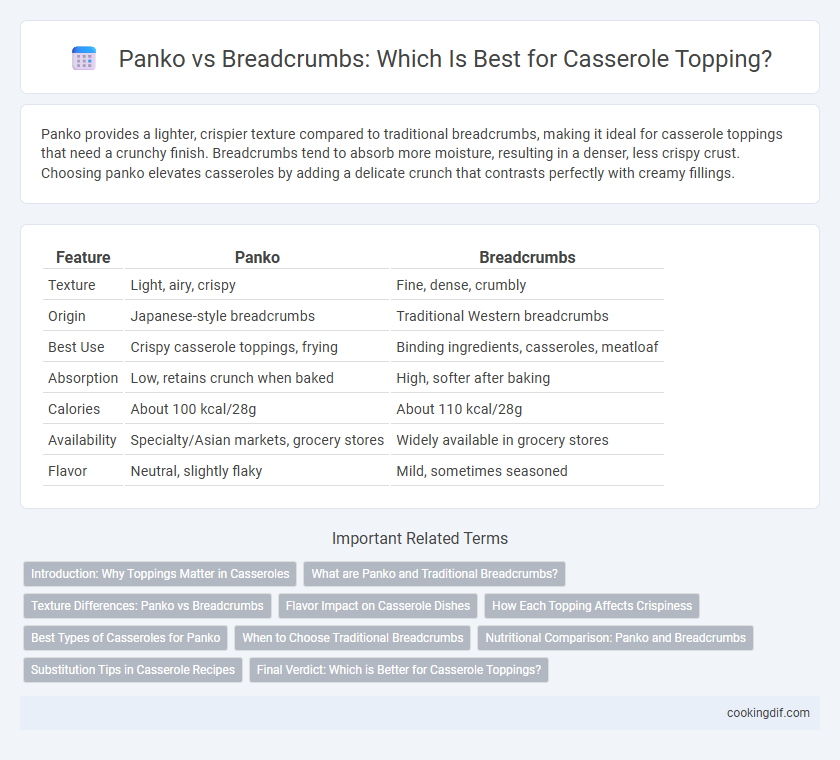Panko provides a lighter, crispier texture compared to traditional breadcrumbs, making it ideal for casserole toppings that need a crunchy finish. Breadcrumbs tend to absorb more moisture, resulting in a denser, less crispy crust. Choosing panko elevates casseroles by adding a delicate crunch that contrasts perfectly with creamy fillings.
Table of Comparison
| Feature | Panko | Breadcrumbs |
|---|---|---|
| Texture | Light, airy, crispy | Fine, dense, crumbly |
| Origin | Japanese-style breadcrumbs | Traditional Western breadcrumbs |
| Best Use | Crispy casserole toppings, frying | Binding ingredients, casseroles, meatloaf |
| Absorption | Low, retains crunch when baked | High, softer after baking |
| Calories | About 100 kcal/28g | About 110 kcal/28g |
| Availability | Specialty/Asian markets, grocery stores | Widely available in grocery stores |
| Flavor | Neutral, slightly flaky | Mild, sometimes seasoned |
Introduction: Why Toppings Matter in Casseroles
Casserole toppings, such as panko and traditional breadcrumbs, play a crucial role in enhancing texture and flavor by creating a crispy, golden crust that contrasts with the creamy interior. Panko crumbs, made from crustless white bread, offer a lighter, airier crunch compared to denser, finer breadcrumbs, making them ideal for achieving a delicate, crispy topping. Choosing the right topping directly impacts the overall sensory experience and visual appeal of casseroles.
What are Panko and Traditional Breadcrumbs?
Panko and traditional breadcrumbs both serve as popular casserole toppings but differ significantly in texture and origin. Panko, originating from Japanese cuisine, consists of large, airy flakes that create a light, crisp crust, while traditional breadcrumbs are finer and denote a denser, more compact topping. Choosing between panko and traditional breadcrumbs can influence the casserole's overall crunch and moisture retention.
Texture Differences: Panko vs Breadcrumbs
Panko offers a light, airy crunch that creates a crispier topping for casseroles, while traditional breadcrumbs provide a denser, finer texture that results in a more compact crust. The coarse flakes of panko allow for better moisture evaporation, enhancing the casserole's contrast between creamy interior and crunchy topping. Breadcrumbs absorb more moisture, often leading to a softer, less distinct crunch compared to panko's crisp bite.
Flavor Impact on Casserole Dishes
Panko crumbs deliver a light, airy crunch that enhances casserole toppings with a subtly nutty flavor, elevating texture without overwhelming the dish. Traditional breadcrumbs provide a denser, more uniform crust that absorbs sauces better, contributing a richer, buttery taste to casseroles. Choosing between panko and breadcrumbs significantly influences the casserole's mouthfeel and flavor profile, making texture and taste harmony essential for a perfectly balanced topping.
How Each Topping Affects Crispiness
Panko breadcrumbs create a lighter, airier topping for casseroles, resulting in an exceptionally crispy and crunchy texture due to their coarser, flakier structure. Traditional breadcrumbs tend to be finer and denser, producing a more compact and less crispy crust that can sometimes become soggy when exposed to casserole moisture. Choosing panko enhances the contrast between creamy casserole fillings and the crispy topping, making it ideal for achieving maximum crunch.
Best Types of Casseroles for Panko
Panko breadcrumbs create a light, crispy topping ideal for casseroles like green bean, chicken, and tuna casseroles, where a crunchy texture enhances the dish. Their larger flakes absorb less oil, resulting in a crunchier crust that holds up well in baked dishes. Panko is especially effective in casseroles with creamy bases or delicate vegetables, providing contrast without becoming soggy.
When to Choose Traditional Breadcrumbs
Traditional breadcrumbs are ideal for casserole toppings when a softer, more uniform texture is desired, as they absorb moisture better and create a cohesive crust. They work best in recipes with sauces or creamy components where a gentle crispiness complements rather than overpowers the dish. Opt for traditional breadcrumbs in casseroles like tuna noodle or chicken pot pie to achieve a tender, golden-brown top that blends smoothly with the casserole's flavors.
Nutritional Comparison: Panko and Breadcrumbs
Panko breadcrumbs typically contain fewer calories and less fat compared to traditional breadcrumbs, making them a lighter option for casserole toppings. Both panko and regular breadcrumbs provide similar amounts of carbohydrates and protein, but panko's airy texture allows for a crispier crust with less oil absorption. Nutritionally, choosing whole wheat or seasoned varieties of either type can add fiber and flavor, enhancing the casserole without significantly increasing calories.
Substitution Tips in Casserole Recipes
Panko breadcrumbs provide a lighter, crispier topping compared to traditional breadcrumbs, making them ideal for casseroles that require a crunchy texture. When substituting regular breadcrumbs with panko, use the same quantity but expect a more delicate crust that browns evenly without becoming dense. For a gluten-free alternative, crushed cornflakes or ground nuts can replace both panko and breadcrumbs, offering a creative twist while maintaining a satisfying crunch.
Final Verdict: Which is Better for Casserole Toppings?
Panko offers a lighter, crunchier texture that crisps up more evenly on casserole toppings compared to traditional breadcrumbs, which tend to be denser and result in a heavier crust. Nutritionally, panko contains fewer calories and less fat, making it a healthier option for those seeking a crispy finish without added heaviness. For casseroles, panko is the better choice to achieve a superior crunch and a visually appealing golden-brown topping.
Panko vs Breadcrumbs for casserole topping Infographic

 cookingdif.com
cookingdif.com